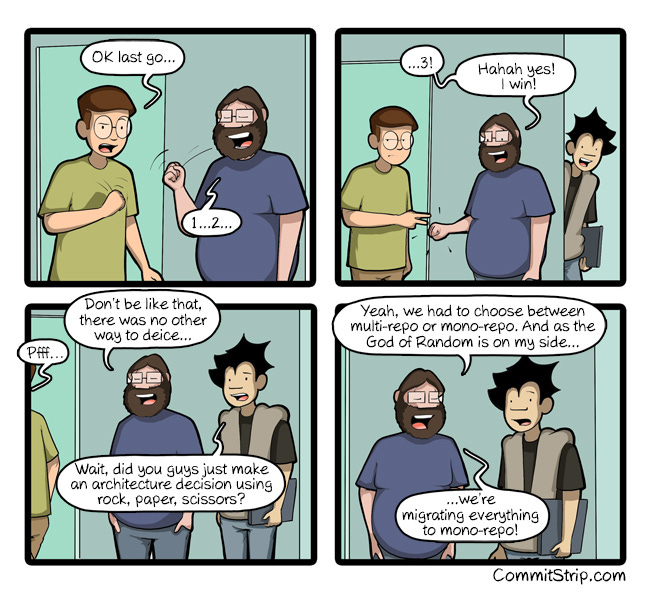The co-founder of a high-growth startup whom I’m currently coaching is currently dealing with the following challenge: he would like his direct reports to take more initiatives and, while they also agree on principle, they always wait for guidance. Even if the general idea about delegation is that managers can’t let go of their control and prevent their direct reports from taking initiatives, I realised that even managers who would like to empower their team, rarely succeed. I was myself one of those managers until I realised that the prerequisite for taking initiative is to have a clear framework and direction, or what U.S. Navy Captain David Marquet and author of Turn the Ship Around! calls organisation clarity:
Clarity means people at all levels of an organisation clearly and completely understand what the organisation is about. This is needed because people in the organisation make decisions against a set of criteria that includes what the organisation is trying to accomplish
When it comes to technology teams, relying on the company’s mission and values is a great basis but is not sufficient to give enough clarity to team members. I believe the best way technology leaders can share organisational clarity to their teams is through a technology vision, a list of bets on your technological future and the team’s core standards.
Your mission statement is not enough
Let’s say you’re the CTO of a SaaS company. Most probably the executive team has come up with a great mission statement, like “organise the world's information” or “help bring creative projects to life”, and values like “commitment to clients” or “being bold”. These are great to inspire the whole company and define a broad framework for decision making. But when you cascade those to your technology teams, they’re not enough. How “being bold” can help your managers decide on a new library, if they should buy an external solution vs building it in-house, or if they should prioritise a refactoring project over a feature asked by an important customer? So, as the CTO, you can always make all those decisions yourself (not a good idea). Or you can trust your managers to make the right decisions based on their gut feeling experience? But if you want to truly scale your organisation and make sure that decisions are made coherently throughout the teams, independently of the managers’ personal views, you need to create and share a technology vision.

As stated above, a technology vision has 2 components: a list of bets on your technological future, and the team’s core standards. The second component, the core standards, is probably the easiest to frame but is rarely done. Most engineers I know have strong opinions about standards. Like deployment velocity, software quality or performance.
What’s interesting is that these standards are usually implicit within the organisation. But what if they’re clearly communicated to the teams and easily accessible? Well, let’s say it’s part of your vision that performance is paramount. Then mechanically, every engineer will always think about performance when working on code architecture or when making implementation decisions. Some might even take the initiative to build a performance bot to benchmark new features before they’re shipped into production. But, what if the decision is more complex, or might have a significant impact in the future? Like having to choose between Kubernetes, Mesos and Docker Swarm. Or choosing your cloud provider. To make such decisions, your managers need to have a sense of where the organisation is going and what you’re anticipating the future to be.
Predicting the future of technologies
I’ve been for some time a strong believer in the fact that all companies will become software companies, and that technology leaders’ decisions will impact not only the tech department but the whole strategy of the company. To help future leaders improve their decision making in the highly complex environment we’re in, I’ve been teaching for some years now a course called Predicting the future of technology (inspired by Amy Webb’s course at NYU). I developed for the course a simple framework to make bets on the future:
1/ Uncover hidden patterns
Like William Gibson used to say, “the future is already here – it's just not evenly distributed”. While we live in a complex and highly changing world, with unpredictable events (not the pandemic though), tools and behaviours from the future are already being used. You just have to know where to look for these patterns or weak signals. When it comes to technology trends, research papers and specialised conferences are always a good place to start. But the most interesting patterns are harder to find. They’re in subreddits, hacker forums and mailing lists, like the one where Satoshi first shared the Bitcoin paper. I also encourage you to chat with fellow CTOs, especially those who have different opinions than you.

2/ Find trends in patterns
Now that you have identified several patterns, which one will emerge as a durable trend and which one will be a simple hype? This is where you should confront the identified pattern with other data points from other successful technological trends. Is FAANG pushing the initiative (with big monies)? Is there a growing open source community? Are engineering students into it, as VC Chris Dixon says, “what the smartest people do on the weekend is what everyone else will do during the week in ten years”.
3/ Make bets
Now that you’ve identified trends you believe will play out in the future, I advise to only focus on those who have the best chance of success in the short to medium term (longer is too long and you’ll have time to update your vision). When making technological bets, the variables to consider are, of course, your company’s objectives, but also the probability of the bet being successful and the risk/reward ratio. Regarding this last point, it might be interesting to make some contrarian bets from time to time, those bets where everyone thinks you’re wrong. Because if you’re right, you'll have a hell of a competitive advantage.
In summary
- For team members to take initiatives, they need to have organisational clarity
- A company’s mission and values are not enough for technology leaders to take initiatives, you need a technology vision as well
- A technology vision is a list of bets on your technological future and the team’s core standards
- Core standards are what engineers should aim for when making decisions
- Bets are anticipation of technological trends
Additional resources
If you’re interested to get more content about predicting the future and making bets, I recommend the following resources:
📖 The Signals Are Talking: Why Today's Fringe Is Tomorrow's Mainstream | Amy Webb
📖 Thinking in Bets: Making Smarter Decisions When You Don't Have All the Facts | Annie Duke
